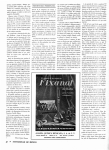Download Bloody Bodily Horrors: Clive Barker`s Hellraiser & AIDS
Transcript
ISSN: 2341-0000 e-ISSN: 2341-071X Bloody Bodily Horrors: Clive Barker’s Hellraiser & AIDS Javier Martín-Párraga Research Group “ Writs of Empire” (HUM 682) [email protected] Received: October 1, 2013! ! Revised version accepted: December 23, 2013 Abstract: From its very origins, horror films have fulfilled a double function that is linked to the Horacian tradition of doccere et delectare. In other words, horror movies are at the same time very exciting free-time killers and canaries in a coal mine that alert American society of the problems and threats that might affect their citizens. This paper analyzes how Clive Barker’s 1987 film Hellraiser satisfies that very same premise since it is both a blockbuster and a reflection of American’s fear towards the incipient yet ominous AIDS virus. Keywords: Horror films, Cliver Barker, Hellraiser, AIDS, Folk Tales. Resumen: Desde sus orígenes, el cine de terror norteamericano ha ejercido una doble función horaciana de doccere et delectare; esto es de servir de instrumento de diversión al mismo tiempo que alertaba a la sociedad de los peligros y problemas que la acechaban. El presente artículo examina cómo la película de Clive Barker del año 1987 Hellraiser cumple ambas funciones, puesto que al mismo tiempo que supone un éxito de público refleja el temor que los estadounidenses sentían ante el incipiente y ominoso virus del SIDA. Palabras clave: Cine de Terror, Cliver Barker, Hellraiser, SIDA, Relatos Populares. IPES International Papers on English Studies 1 (2013) 25-46 26 Javier Martín-Párraga POPULAR NARRATIVES AND THEIR SOCIAL FUNCTIONS From the dawn of times, folktales have played a fundamental social role at the same time they functioned as entertainment elements for families and small communities that had difficult, if not impossible, access to more ambitious cultural or leisure options. In this way, bards first and jongleurs later walked the old paths delighting their audiences at the same time they brought them ideas, ideals and myths that cemented the very foundations of the societies, religious and political systems of their times. Thus, it is virtually impossible to separate oral poetry and folktales from the magnificent paintings, sculpture or architectonical pieces of the period, that were created following the very same principles and to serve identical goals. As a result, those ancient tales that were narrated from father to son at the heat of the common fire were dual in essence and followed Horatian principles, since they were both gates to escapism and knowledge. It’s in this context that Carmen González and Luis Unceta affirm that, los aedos o rapsodas hicieron su aparición, convirtiéndose en los ‘generadores’ o ‘guionista’ de los primeros ‘folletines o culebrones’ de la historia que, tanto hoy como ayer, tuvieron el mérito de calar en la mentalidad colectiva, creando adicción en las clases medias y populares por su capacidad de conmover los sentimientos más hondos y primarios del ser humano (15). Andrea Dworking confirms the seminal role folktales play in the creation and consolidation of the individual, “We have taken the fairy tales of our childhood with us into maturity, chewed but still lying in the stomach, as real identity” (32). Carolyn Heilbrun agrees with Dworking and states that, “out of old tales, we must make new lives” (109). It is not the aim of the present paper to study in depth the many reasons why folktales are so fundamental for the societies in which they were formulated. Nevertheless, it must be taken into account that the democratic nature of this type of artistic manifestation contributes to this fact in a determining manner. Folktales are invented, transmitted, received and reformulated in an absolutely free manner. Free in the economic and artistic senses. Since they are oral, any person with the ability to participate in a conversation and memorize a short text will be able to enjoy receive first and later disseminate any given folktales. Thus, the economic burdens painter, sculptors or architects found. On the other hand, the oldfashioned binary opposite high/pop art clearly included folktales in the second category. Thus, they were free from the rigid stylistics corsets that were imposed to “sophisticated IPES International Papers on English Studies 1 (2013) 25-46 Bloody Bodily Horrors: CIive Barker’s... 27 high art”. As a result, neither bards nor audiences needed any previous formal instruction. What is more, the simpler the tale, the more effective and engaging it becomes. At this point, it becomes necessary to avoid the mistake of considering pop art as inherently inferior to high art. As Bruno Bettelheim explains, folktales are not only complex and sophisticated but also subtle, through the centuries (if not millennia) [...] fairy tales came to convey at the same time they overt and covert meanings- came to speak simultaneously to all levels of the human personality, communicating in a manner which reaches the uneducated mind of the children as well as the sophisticated adult (6-7). Sandra Gilbert and Susan Gubar reinforce Bettelheim’s opinion in the following quotation; “myths and fairy tales often both state and enforce culture’s sentences with greater accuracy than more sophisticated literary texts” (36). As Kimberly J. Lau explains, if folktales are more effective than other artistic manifestations is due to their symbolic nature: the coupling of a tale's structure with the social context of the culture in which it flourishes lends insight which is invaluable in deciphering its symbolic significance. In turn, its symbolic significance is crucial to understanding any social or cultural meaning which it might bear (233). If their democratic nature and ability to become loaded with symbolism made popular tales an excellent vehicle for the transmission of ideals and values, the tendency they show to include grotesque, or even horrendous, elements also fostered their rapid adoption by societies all over the world. Maria Tatar reflects on the morbid elements contained in the majority of fairy tales in the following lines, for many adults, reading through an unexpurgated edition of the Grimms' collection of tales can be an eye-opening experience. Even those who know that Snow White's stepmother arranges the murder of her stepdaughter, that doves peck out the eyes of Cinderella's stepsisters, that Briar Rose's suitors bleed to death on the hedge surrounding her castle, or that a mad rage drives Rumpelstiltskin to tear himself in two will find themselves hardly prepared for the graphic descriptions of murder, mutilation, cannibalism, infanticide, and incest that fill the pages of these bedtime stories for children (3). As Sergi Sánchez explains, “el dolor es fruto de una construcción cultural. Lo que significa que también es un estado mental… el dolor es una de las fantasías que las sociedades inventan para respetar el orden, codificar el miedo, temer a la muerte” (180). Thus, the IPES International Papers on English Studies 1 (2013) 25-46 28 Javier Martín-Párraga horrid nature of popular stories guarantees audiences’ attention at the same time it serves a fundamental socio-cultural function. Once again, the Horatian essence of folktales becomes evident. The theories of catharsis and the sublime must, consequently, be remembered at this point, because the atrocities and brutalities staged in Oedipus Rex or the darkest Old Testamentary passages are not far away from the ones audiences could face in the original, unabridged and non-Disney, fairy tales. FROM THE CHIMMEY TO THE SILVER SCREEN Folktales and oral stories do not disappear in the context of capitalism and modernity, but the inner structures of the twentieth and twenty-first centuries let few moments to be enjoyed by families in a relaxed environment. Thus, as Herbert Marcuse states, in western capitalistic societies “las necesidades sociales deben convertirse en necesidades individuales” (106). As a result, our children will no longer be explained that leaving the city and entering the forest with an unknown man is dangerous by a fairy tale but rather by a cultural artifact that is disseminated/broadcasted through the mass media. According to Deleuze, films are the ideal socio-cultural manifestations of contemporary societies because, los primeros que hicieron cine y pensaron en él partían de una idea simple: el cine como arte industrial alcanza el automovimiento, el movimiento automático, hace del movimiento el dato inmediato de la imagen. Este movimiento ya no depende de un móvil o de un objeto que lo ejecutaría, ni de una mente que lo reconstruiría. La propia imagen, en sí misma, se mueve. En este sentido no es, por lo tanto, ni figurativa ni abstracta. […] la imagen cinematográfica “hace” ella misma el movimiento, porque ella hace lo que otras artes se limitan a exigir (o a decir), ella recoge lo esencial de las otras artes, hereda de ellas, es como el modo de empleo de las otras imágenes. Convierte en potencia lo que sólo era posibilidad. El “movimiento automático” hace que se eleve en nosotros un “autómata espiritual” que reacciona a su vez sobre él. El autómata espiritual ya no designa, como en la filosofía clásica, la posibilidad lógica o abstracta de deducir formalmente los pensamientos unos de otros, sino el circuito en el cual éstos entran con la imagen-movimiento, la potencia común de aquello que fuerza a pensar y de aquello que piensa bajo el choque: un “nochoque”. Heidegger dirá: “El hombre sabe pensar en tanto que tiene esta posibilidad, pero este posible no garantiza todavía que seamos capaces de hacerlo”. Es esta capacidad, esta potencia, y no la simple posibilidad lógica, lo que el cine pretende darnos al comunicarnos el choque. Es como si el cine nos dijera: conmigo, con la imagen-movimiento, no podéis escapar al choque que despierta en vosotros el pensador. Un autómata subjetivo y colectivo para un movimiento automático: IPES International Papers on English Studies 1 (2013) 25-46 Bloody Bodily Horrors: CIive Barker’s... 29 el arte de las “masas” (209-10). Paolo Chechi Usai agrees with Deleuze and goes one step beyond in the following quotation, el principio rector de la Imagen Moral es la pasividad. Ésta comporta un esfuerzo por minimizar cualquier intervención que tenga como finalidad la ocultación del hecho de que la imagen en movimiento tiene una historia genéticamente determinada y un tiempo de vida limitado (107). It is also worth quoting Gian Piero Brunetta, who explains this same phenomenon in a more aseptic, less conditioned by political ideologies, way: El dato fenoménico es repetido como si la imagen fuese reflejo de una realidad e incluso realidad en sí misma, sin intervención de proceso alguno de semantización de los elementos que entran en su campo, ni de pensamiento o principio organizador alguno si no es la estructura mononucleica (…) La imagen refleja la realidad y como tal se torna el lugar de unificación fenoménica (30-31). It is important to bear in mind that even when films as we understand them today needed a series of technical advances that were not present till the twentieth century, human beings have been trying to reproduce images in movement that would convey both aesthetic pleasure and social and moral messages. Antoni Capilla & Nuria Vidal explain this idea in detail: Las enciclopedias suelen definir la cinematografía como el arte de representar, sobre una pantalla, imágenes en movimiento por medio de la fotografía. Un arte, el cinematográfico, que hace realidad una de las obsesiones del ser humano a lo largo de toda la historia… Nuestros antepasados prehistóricos ya dibujaban bisontes con seis patas en sus cavernas para reproducir o imitar la realidad. Aquellos primitivos artistas iban más allá de intentar una reproducción fiel, exacta y completa del medio en que vivían. Intentaban darle una nueva dimensión, el movimiento. Años más tarde, los egipcios demostraron conocer el principio científico de la persistencia de la visión. El faraón Ramsés, por ejemplo, decoró el exterior de un templo, 12 siglos antes de Cristo con las diferentes fases de una figura en movimiento que, al contemplarse sobre un caballo a galope producían la ilusión óptica de movimiento (15). As a result, no matter how different their technical requirements were, films and oral stories did not differ that much in their essence and aims, since as Martin M. Winkler explains, the light of the cinema… instigated a profound change in Western culture- from reading stories to viewing stories, from literature to image, from linguistic text to cinematic text. IPES International Papers on English Studies 1 (2013) 25-46 30 Javier Martín-Párraga As much as this was a radical break with the past, it was also a continuation of the entire tradition of human civilization (4). AMERICAN HORROR FILMS As it has been proved in previous sections, films became the natural heirs of folktales in the twentieth century. They seduce spectators with their magic at the same time they are transmitting atemporal social messages like not abandoning urban scenarios, not trusting unknown individuals, valuing family upon any other thing on earth, etc. Thus, from the origins of film industry, movies from every nation and genre became loaded with socio-political connotations. Nevertheless, the role of cinematic products as vehicles of propaganda became especially important during World War II and its aftermath. Roosevelt did frequently employed television and short films to get in touch with his citizens. The president’s masterly use of these new mass media was so impressive that scholars such as Giuliana Muscio don’t hesitate to refer to him as an authentic showman (21). Roosevelt did not only took advantage of the many radio and TV stations and film companies in the US but invested an important measure of energy and time to create the Division of Cultural Relations (DCR), that produced documentaries as well as fiction pieces (León Aguinaga, 2010: 161). The impact of the many productions budgeted by DCR on American society was certainly important during the war and became fundamental in the posterior Cold War scenario. Nevertheless, and important as the public enterprise was, DCR was not but the tip of a colossal iceberg that included Walt Disney, Universal, Metro Goldwyn Mayer or Warner Bros. Thus, American films became not only the best allies for the local political government but also the best ambassadors of the American Dream in a period characterized by political and ideological division. As Pierre Solin explains, hoy en día nos resulta difícil imaginar lo apasionados que eran los sentimientos que Hollywood despertaba entre la gente, por más que sus sentimientos de animadversión sean comprensibles. Por una parte, los devastados países europeos no estaban dispuestos a malgastar sus preciosos dólares americanos comprando películas americanas, pero por la otra, dada la debilidad de la producción nacional, era imposible salir adelante sin la fábrica de sueños más grande del mundo (95). From a general perspective, any American audiovisual product serves social functions, but as Rodolfo Vidal explica, “los efectos de la comunicación de masas tienden a tomar forma de refuerzo más que de cambio” (2006: 32). Thus, the main ideological target for films and IPES International Papers on English Studies 1 (2013) 25-46 Bloody Bodily Horrors: CIive Barker’s... 31 television products were the children and teenagers who were supposedly more fragile and prone to be poisoned by the communist propaganda. As a result, those movies that appealed to younger audiences, didn’t even try to hide their propaganda overtones. And fantastic or horror films have always been the favorite genre for American young generations, from the classic monsters of the Universal to contemporary examples such as Saw. All in all, as Román Gubern & Joan Prat defend: [Este género] forma desde hace años parte integrante del folklore de la sociedad industrial… mitos como Drácula, Frankenstein, o el Hombre-Lobo resultan tan significativos para entender las neurosis, las frustraciones y los déficits colectivos de nuestra sociedad como lo resultan un dios de la lluvia o una diosa de la fecundidad en viejas culturas neolíticas (11). In previous works I have studied the political implications on science fiction/horror films like Invasion of the Body Snatchers (1956), The Last House on the Left (1972) or The Exorcist (1973) from a general perspective. In this paper, I will apply the theoretical framework to a very specific historical event and particular movie. HELLRAISER & HELLBOUND HEART In 1986, British artist and filmmaker Clive Barker wrote The Hellbound Heart, a novella that became an instant cult classic and proved that Barker was destined to be one of the most influential fantasy/horror writers in contemporary English literature. As a matter of fact, soon after the publication of this novella, Barker will be declared “the next Stephen King”, both by publishers and readers. By 1986, Barker’s had already shown interest in the film industry and was the author of two experimental short movies (Salome [1973] and The Forbidden [1976]) and two modest screenplays that were shot and given limited release in the USA (Transmutations [1985] and Rawhead Rex [1986]). As a result of the good reception of The Hellbound Heart and the author’s desire to become a film director, the novella was soon adapted into a screenplay by Barker himself. Taking into account the nature of the project, the graphic scenes the final movie would contain and Barker’s lack of contacts in Hollywood, the production was not easy since none of the big companies shown any interest. As a result, Barker needed to involve three small companies in order to gather the 1,000,000 dollars budget Hellraiser will finally count with. Once finished, the prestige of Barker and the resulting products convinced American distributors of giving Hellraiser a solid theatrical release, with 1,132 theaters showing the film. The first IPES International Papers on English Studies 1 (2013) 25-46 32 Javier Martín-Párraga weekend, Barker’s opus primum as a director opened with more than 4,000,000 dollars in tickets and during its 4 weeks of exhibition the grand total amounted to $14,564,027. In the UK the film didn’t become as successful as in the US, but its debut sold £155,348 in tickets and achieved a grand total of £763,412. All in all, Hellraiser was not a blockbuster in the line of Indiana Jones, but taking into account its more than modest budget became a very profitable film for producers, distributors and Barker himself. As I have shown above, the movie constituted a remarkable commercial success during its first theatrical release. Anyhow, the true importance of Hellraiser will be achieved in a gradual manner and nowadays it is safe to say that it is not only one of America’s most famous and influential horror films but also a true cult classic with thousands of devotees that create webpages and forums, fanzines and even short films and novels inspired on the original movie. It is also important to mention that the success of the first installment gave origin to 8 sequels. Barker did collaborate with the screenwriter of the first sequel but refused to collaborate but subsequent products. As a result, from Hellraiser II to the fifth movie, the sequels will be poorly produced and didn’t receive a wide release and Hellraiser V to IX were direct-to-video releases. As Paul Kane explains, the last Hellraiser movies have only been produced so the production company (Dimension Films) could retain the rights for future remakes of the original film. In the present paper I will exclusively focus on Hellraiser I and the novella in which it was inspired, The Hellbound Heart. Both start with an introduction in which the audience meets the character of Frank. He is absolutely absorbed in the solving of a mysterious (and we feel, uncanny) tridimensional puzzle. The puzzle is an extraordinary piece, due to its overly complex artisanal engineering, its subtle and intricate baroque decorations and, above all, because of its magical and supernatural qualities. As the puzzle is being solved, strange and mournful lugubrious sounds escape, accompanied in the last instance by bells slowly and distantly tolling dark notes. Once Frank completes all the movements, the puzzle is solved and the box gets open. From that point on it will no longer be a piece of craftsmanship but a door to a disquieting and disturbing realm. Both reader and spectator feel there is no way back. In the novella, the complex puzzle/box/key is given several names, but its most notable one refers to its creator, “Lemarchand's box”. As we see, the The Hellbound Heart reveals the name of the artefact from the very beginning, together with a certain amount of information on the unholy object: IPES International Papers on English Studies 1 (2013) 25-46 Bloody Bodily Horrors: CIive Barker’s... 33 The device had been constructed by a master craftsman, and the riddle was this-that though he'd been told the box contained wonders, there simply seemed to be no way into it, no clue on any of its six black lacquered faces as to the whereabouts of the pressure points that would disengage one piece of this three-dimensional jigsaw from another. […] Frank had seen similar puzzles-mostly in Hong Kong, products of the Chinese taste for making metaphysics of hard wood-but to the acuity and technical genius of the Chinese the Frenchman had brought a perverse logic that was entirely his own. […] The sound was coming from somewhere much more distant, through the very door (as yet invisible) that Lemarchand's miraculous box had been constructed to open. Everything that Kircher, who had sold him the box, had promised of it was true! He was on the threshold of a new world, a province infinitely far from the room in which he sat (1-3) In contrast, Barker the screenwriter prefers to postpone this information: On the blood-spattered floor, a box, some six inches square, which resembles an elaborate Chinese puzzle box. Later, we'll learn its name and function. It's called the Lament Configuration, and it's a way to raise Hell. LITERALLY. For now, it remains an enigma. If the film prefers to create its atmosphere without getting into further details, the novella does not hesitate to dive further into the genesis of “Lemarchand's box” and how it got into Frank’s hands. How had he first heard about Lemarchand's box? He couldn't remember. In a bar maybe, or a gutter, from the lips of a fellow derelict. At the time it was merely a rumor-this dream of a pleasure dome where those who had exhausted the trivial delights of the human condition might discover a fresh definition of joy. And the route to this paradise? There were several, he was told, charts of the interface between the real and the realer still, made by travelers whose bones had long since gone to dust. One such chart was in the vaults of the Vatican, hidden in code in a theological work unread since the Reformation. Another-in the form of an origami exercise, was reported to have been in the possession of the Marquis de Sade, who used it, while imprisoned in the Bastille, to barter with a guard for paper on which to write The 120 Days of Sodom. Yet another was made by a craftsman-a maker of singing birds-called Lemarchand, in the form of a musical box of such elaborate design a man might toy with it half a lifetime and never get inside. Stories. Stories. Yet since he had come to believe in nothing at all it was not so difficult to IPES International Papers on English Studies 1 (2013) 25-46 34 Javier Martín-Párraga put the tyranny of verifiable truth out of his head. And it passed the time, musing drunkenly on such fantasies. It was in Düsseldorf, where he'd gone smuggling heroin, that he again encountered the story of Lemarchand's box. His curiosity was piqued once more, but this time he followed the story up until he found its source. The man's name was Kircher, though he probably laid claim to half a dozen others. Yes, the German could confirm the existence of the box, and yes, he could see his way to letting Frank have it. The price? Small favors, here and there. Nothing exceptional. Frank did the favors, washed his hands, and claimed his payment. There had been instructions from Kircher, on how best to break the seal on Lemarchand's device, instructions that were part pragmatic, part metaphysical. To solve the puzzle is to travel, he'd said, or something like that. The box, it seemed, was not just the map of the road, but the road itself (120-1). Hellraiser, on the contrary, does not solve the mystery of the box till the film is about half-way to its climax and the information is not only succinct but also quite ambiguous: FRANK This is what began it. JULIA A box ? FRANK It's not any box. It's called the Lament Configuration. It's a puzzle. JULIA (Reaching for it) Let me see. FRANK Don't touch it. It's dangerous. It opens doors. JULIA What kind of doors ? FRANK To experience beyond anything ever known. At least that's what I was promised when I bought it. Pleasure from Heaven or Hell. I didn't much care which. JULIA Hell ... IPES International Papers on English Studies 1 (2013) 25-46 Bloody Bodily Horrors: CIive Barker’s... 35 FRANK I was bored. I'd done everything. I'd gone to the limits. There was nothing left to experience. At least nothing I could buy on earth. Hellraiser is less prone to unveil the secrets of the box due to several reasons. On the first hand, the nature of the written and visual artistic artefact is quite different and the 90 minutes of celluloid that typically last a horror film offer little time for flashback of this sort. Secondly, Barker and the producers trusted the film could be economically profitable and felt the necessity to leave some paths open for a future sequel (as a matter of fact, Hellraiser II will deal with the origins of the puzzle). In any case, both novella and film are clear from the very beginning: far from being and innocent victim hit, the character of Frank had some knowledge about the puzzle and the repercussions of opening it and takes significant efforts in order to do so. This fact is important in two ways. Firstly, it connects the Hellraiser mythology with that of the ancient myths of Eve’s apple and Pandora’s box. Second, and even more important, by presenting a character that is aware of the implications of his actions, Barker is following one of the most important conventions of horror fiction: the victim is never fully innocent. In this respect, the victims in these contemporary cultural manifestations are heirs to the Aristotelian’s tragic heroes that were not fully guilty or innocent (a depraved character being severely punished by his evil deeds would not drive audience to pathos, neither in Greek tragedies nor Hollywood horror franchises). If Eve was trying to satisfy her inherent curiosity and Pandora didn’t resist the temptation to know what secrets were hidden inside the cursed box in a similar manner, Frank is clearly interested in more fleshly discoveries, since he wanted to open the puzzle to get in touch with “the Cenobites, theologians of the Order of the Gash. Summoned from their experiments in the higher reaches of pleasure, to bring their ageless heads into a world of rain and failure” (8). The following quotation is even more explicit about Frank’s urges and motivations, All that mankind knew of the Order of the Gash, he knew. And yet...he had expected something different. Expected some sign of the numberless splendors they had access to. He had thought they would come with women, at least; oiled women, milked women; women shaved and muscled for the act of love: their lips perfumed, their thighs trembling to spread, their buttocks weighty, the way he liked them. IPES International Papers on English Studies 1 (2013) 25-46 36 Javier Martín-Párraga He had expected sighs, and languid bodies spread on the floor underfoot like a living carpet; had expected virgin whores whose every crevice was his for the asking and whose skills would press him-upward, upward-to undreamed-of ecstasies. The world would be forgotten in their arms. He would be exalted by his lust, instead of despised for it (9). The movie adaptation is less explicit about the character’s sexual intentions but does not hesitate to portray “pictures of a good-looking intense man in his mid to late thirties [Frank], in bed with a naked Chinese girl” among other objects Frank gathered while travelling around the world in search of the unconventional pleasures that will end up with him meeting the Lament Configuration. Barker does not only avoid offering an innocent character, but is especially interested in remarking the free-will Frank enjoyed and, thus, the voluntariness of his actions, since even after solving the puzzle he is given a final opportunity, "The Engineer will arrive should the moment merit," came the reply. "Now again, we ask you: What do you want." Why should he not answer them straight? "Pleasure," he replied. "Kircher said you know about pleasure." "Oh we do," said the first of them. "Everything you ever wanted." "Yes?" "Of course. Of course." It stared at him with its all-too-naked eyes. "What have you dreamed?" it said. The question, put so baldly, confounded him. How could he hope to articulate the nature of the phantasms his libido had created? He was still searching for words when one of them said: "This world...it disappoints you?" "Pretty much," he replied. "You're not the first to tire of its trivialities," came the response. "There have been others." "Not many," the gridded face put in. "True. A handful at best. But a few have dared to use Lemarchand's Configuration. Men like yourself, hungry for new possibilities, who've heard that we have skills unknown in your region." "I'd expected-" Frank began. "We know what you expected," the Cenobite replied. "We understand to its breadth and depth the nature of your frenzy. It is utterly familiar to us." Frank grunted. "So," he said, "you know what I've dreamed about. You can supply the pleasure. IPES International Papers on English Studies 1 (2013) 25-46 Bloody Bodily Horrors: CIive Barker’s... 37 The thing's face broke open, its lips curling back: a baboon's smile. "Not as you understand it," came the reply. Frank made to interrupt, but the creature raised a silencing hand. "There are conditions of the nerve endings," it said, "the like of which your imagination, however fevered, could not hope to evoke." "...yes." "Oh yes. Oh most certainly. Your most treasured depravity is child's play beside the experiences we offer." "Will you partake of them?" said the second Cenobite. Frank looked at the scars and the hooks. Again, his tongue was deficient. "Will you?" Outside, somewhere near, the world would soon be waking. He had watched it wake from the window of this very room, day after day, stirring itself to another round of fruitless pursuits, and he'd known, known, that there was nothing left out there to excite him. No heat, only sweat. No passion, only sudden lust, and just as sudden indifference. He had turned his back on such dissatisfaction. If in doing so he had to interpret the signs these creatures brought him, then that was the price of ambition. He was ready to pay it. "Show me," he said. "There's no going back. You do understand that?" "Show me. " They needed no further invitation to raise the curtain (11-12). In the film version, this final negotiation is not shown on-screen but rather implied. Nevertheless, spectators will be clearly explained that Frank accepted the blasphemous present offered to him by the Cenobites. Nevertheless, the character of Frank is clearly not an innocent one. Thus, he will not fully fulfil the Aristotelian and horror films genre prerequisites of a basically decent character that commits a fatal mistake and is thus punished. As a result, in the movie he does suffer every kind of torment, but another more innocent victim must be added in order to connect with the audience in a more fruitful manner. This new character will be rooted to the very foundations of the horror genre: a young virginal girl who, Pandora or Eve-like, is not guilty of any other crime but that of excessive curiosity (which is, on the other hand, not far away from the hubris of classical tragic heroes like Oedipus or biblical characters such as Lot’s wife). When this new character, which did not know much about the hideous nature of the puzzle and is not looking to satisfy any depraved sexual urge, opens the box the Cenobites do not IPES International Papers on English Studies 1 (2013) 25-46 38 Javier Martín-Párraga give her the same opportunity of repenting they gave to Frank: CENOBITE The box ... you opened it. We came. KIRSTY It's just a puzzle box. CENOBITE It's a means to summon us -it's called the Lament Configuration. KIRSTY Who are you? CENOBITE Cenobites. Explorers in the further regions of experience. Demons to some. Angels to others. KIRSTY Well, I didn't mean to open that thing. You can go back wherever you came from. FEMALE CENOBITE We can't. Not alone. At this, the creature with the wired open jaw chatters like a mad monkey. KIRSTY This isn't for real. CENOBITE You solved the box. We came. Now you must come with us. Taste our pleasures. Even they show themselves as uncompromising, and yet fair in their own satanic terms, when Kirsty explains her mistake and identifies Frank (who had escaped from the Cenobites’ realm thanks to a drop of blood accidentally spilled on the place where he was abducted) as the true owner of the box, she is given an opportunity. As we see, Barker is giving the audience a true evil character as well as a mostly innocent one. Together with a set of monsters and a final scene in which the righteous one will survive and the cursed one will be taken back to the endless horrors of Leviathan (as it is called the Cenobites’ kingdom). THE THREAD AIDS The fundamental difference between The Hellbound Heart and Hellraiser will be the sexual and erotic nature of the Cenobites. In the novella, the theologians of the Order of the Gash did certainly offer sexual-related pleasures and throughout history they had fostered and even made possible the depravity of infamous characters such as Giles de Rais o the IPES International Papers on English Studies 1 (2013) 25-46 Bloody Bodily Horrors: CIive Barker’s... 39 Marquis of Sade. Nevertheless, their own sexual features is not clearly defined, since they are described in the following terms, A fitful phosphorescence, like the glow of deep-sea fishes: blue, cold, charmless. It struck Frank that he had never once wondered what they would look like. His imagination, though fertile when it came to trickery and theft, was impoverished in other regards. The skill to picture these eminences was beyond him, so he had not even tried. Why then was he so distressed to set eyes upon them? Was it the scars that covered every inch of their bodies, the flesh cosmetically punctured and sliced and infibulated, then dusted down with ash? Was it the smell of vanilla they brought with them, the sweetness of which did little to disguise the stench beneath? Or was it that as the light grew, and he scanned them more closely, he saw nothing of joy, or even humanity, in their maimed faces: only desperation, and an appetite that made his bowels ache to be voided (10). As it results evident, Barker’s most obvious inspirations in the book are Bosch’s and H.R. Giger’s paintings and the undetermined pantheon of monstrous beings that populate H.P. Lovecraft’s fictional universe. In a later moment, the lack of sexual identity of the Cenobites is made explicit when they are defined as “these sexless things, with their corrugated flesh” (11). Therefore, Barker offers a series of creatures that are deprived of any sexual element and whose most prominent features are the “scars that covered every inch of their bodies, the flesh cosmetically punctured and sliced and infibulated, then dusted down with ash” (7). No matter how relaxed our definition of erotism might be, it would be extremely difficult to conceive they are remotely sexy or sensual. In his first screenplay, Barker maintained the chirurgical modifications made on the Cenobites’ bodies and their inhuman nature: Standing across the room from her, lit by a strange phosphorescence that has no visible source, are four extraordinary figures. They are CENOBITES. Each of them is horribly mutilated by systems of hooks and pins. The garments they wear are elaborately constructed to marry with their flesh, laced through skin in places, hooked into bone. The leader of this quartet has pins driven into his head at inch intervals. At his side, a woman whose neck is pinned open like a vivisection specimen. Accompanying them is a creature whose mouth is wired into a gaping rectangle - the exposed teeth sharpened to points, and a fat sweating monster whose eyes are covered by dark glasses. IPES International Papers on English Studies 1 (2013) 25-46 40 Javier Martín-Párraga Nevertheless, after the complex and superb efforts made by the lead costume designer, Joanna Johnston and the team of makeup department, the Cenobites that will appear onscreen offer the following aspect: IPES International Papers on English Studies 1 (2013) 25-46 Bloody Bodily Horrors: CIive Barker’s... 41 As the images above clearly illustrate, the film Cenobites are still certainly disturbing and uncanny, but they are far from being asexual both in their costumes and in their lascivious attitudes. From a merely aesthetic perspective, their costumes clearly resemble the aesthetics of some gay and BDSM communities that were emerging and gaining (some) visibility at the time the movie was shot. I would like to compare the film images reproduced here with the next set of images, that have been taken from a sex shop catalogue: The resemblance between the garments worn by the monsters of the film and the models is stunning. Clive Barker, a homosexual author who did visit San Francisco (cradle of these sexual and aesthetic radical movements) needed to be familiar with gay BDSM’s attires, since they were not difficult to find not only on dark more or less hidden clubs but also in art galleries and mainstream magazines. The images I reproduce now were already iconic in 1987, IPES International Papers on English Studies 1 (2013) 25-46 42 Javier Martín-Párraga Tom Nicholl (50’s) Peter Berlin (mid 70’s) Robert Mapplethorpe (70’s) Jim Wigler (años 80’s) As it has been proved, the connections between Hellraiser’s dark deities and the gay and fetish communities in America and the UK are not exactly subtle. It could be argued that the deep changes theses characters experience when transformed into film characters can only respond to the undeniable visual shocking values Barker found in the underground radical sexual communities. But I do maintain that the change is far from being coincidental and goes beyond the purely aesthetic dimension. As I defended in the first sections of this paper, horror films in America are the true heirs of folktales and therefore must fulfill both an IPES International Papers on English Studies 1 (2013) 25-46 Bloody Bodily Horrors: CIive Barker’s... 43 entertainment and a moral function. Thus, it is highly improbable that Barker made his movie Cenobites look like the members of a radical open sexual community without even considering the socio-political implications underlying this decision. This fact results even more improbable if we take into account the historical context and the narrative of the movie itself. On June 5, 1981 the American Government Center for Disease Control published an alarming article in which informs of the apparition of a new infection of unknown origin and etiology. But, even assuming very little is known about this new serious health thread; the CDC emphasizes the fact that the five victims identified so far were members of the homosexual collective. The reasons behind this affirmation were clearly politically contaminated, since it is not only impossible but openly absurd to assert that a new disease is exclusive of a collective when only 5 individuals had been studied so far. Nevertheless, American public opinion did not hesitate to accept that AIDS was sexuallyrelated and thus was closer to a Biblical curse than to a natural infection that could affect any citizen, independently of his or her sexual orientation. Thus, by 1982 The New York Times had already made popular a new name for the disease, GRID (gay-related immune deficiency). Very soon, more mature medical evidences alerted that the terrible virus had nothing to do with homosexuality and that even the most pious of the WASP could be at risk. But the mass media, and consequently a great portion of the public opinion, would still take years to accept the possibility of a global thread, favoring the much more comforting idea that God was simply punishing sodomites. It is important to remember that even some American States did offer gay people equal rights pretty soon, a big portion of the country keeps considering homosexuality as an illness, or even a crime. In this respect, I would like to reproduce a section of Texas’ legislation that was not abolished till the year 2003: § 21.06. Homosexual Conduct (a) A person commits an offense if he enganges in deviate sexual intercourse with another individual of the same sex. (b) An offense under this section is a Class C misdemeanor (http://www.sodomy.org/laws/texas/sodomy.html) The misleading (and extremely dangerous, both from a social and sanitary perspective) conception that bound AIDS and homosexuality was also consolidated due to the fact that the first famous victims of AIDS were actually homosexual, such as Rock Hudson (who died in 1984), or Freddie Mercury that died in the year 1991 but whose condition of AIDS victim was known since the mid 80’s. At this point, it becomes useful to show an image of Mercury IPES International Papers on English Studies 1 (2013) 25-46 44 Javier Martín-Párraga in which the rock star wore some clothes that would equally fit the BDSM and Cenobite communities. CONCLUSIONS Folktales like “Little Red Riding Hood” did not warm young audiences about the dangers of transvestite wolves but about how risky would be to abandon society and enter the forest. Not to speak of trusting unknown people. In a similar way, classic horror and science fiction movies like Invasion of the Body Snatchers were not asking American youngsters to pay attention to any possible hidden alien invasion but rather to spy on the neighbor. Just in case he was reading Marx. The situation with Hellraiser is very similar, indeed. A curious, morally ignorant, character looks for the Lament Configuration, trying “to experience beyond anything ever known. At least that's what I was promised when I bought it. Pleasure from Heaven or Hell. I didn't much care which”. Then, he is consequently opened the door of a hell in which a group of monsters characterized as fetishistic gays would torture and degrade his body and soul forever and beyond redemption. The political reading of the movie is as self-evident as conservative: stick to traditional sex, with no innovation or deviation, and your body will be free from the horrors of AIDS and your reputation free from the humiliations inherent to a disease that is moral in nature and won’t affect but depraved and perverted individuals. IPES International Papers on English Studies 1 (2013) 25-46 Bloody Bodily Horrors: CIive Barker’s... 45 WORKS CITED ADORNO, Theodor & Theodor y HORKHEIMER, Marx. The Culture Industry: Enlightenment as Mass Deception. London: Blackwell Publishers, 2001. BARKER, Clive. The Hellbound Heart. London: Dark Harvest, 1986. BETTELHEIM, Bruno. The Uses of Enchantement. New York: Knop, 1976. BENNET, Vicente. La Cultura del Cine. Barcelona: Paidós, 2004. BRUNETTA, Gian. Nacimiento del Relato Cinematográfico. Madrid: Cátedra, 1993. CAPILLA, Antoni & VIDAL, Nuria. Orígenes del Cine. Valladolid: Divisa, 2007. CASHDAN, Susan. The Witch Must Die: How Fairy Tales Shape Our Lives. New York: Basic Books, 1999. CHERCHI, Pier. La Muerte del Cine. Barcelona: Laertes, 2006. DELEUZE, Gilles. La Imagen-Tiempo. Estudios sobre Cine 2. Barcelona: Paidós, 1986. DWORKIN, Andrea. Woman Hating. New York: Dutton, 1974. GARCÍA, Emilio. Cine e Historia. Las Imágenes de La Historia Reciente. Madrid: Arcolibros, 2002. GILBERT, Sara y GUBAR, Susan. The Madwoman in the Attic: The Woman Writer and the Nineteenth-Century Literary Imagination. New Haven: Yale University Press, 2000. GONZÁLEZ, Carmen & UNCETA, Luis. Literatura Clásica, Estética y Cine Contemporáneo: Épica. Madrid: Servicio de Publicaciones de la Universidad Autónoma de Madrid, 2007. GUBERN, Ramón & PRAT, Joan. Las Raíces del Miedo: Antropología Del Cine De Terror. Barcelona: Tusquets, 1979. HEILBURN, Carolyn. Hamlet's Mother and Other Women. Gender and Culture. New York: Columbia University Press, 1990. KANE, Paul. The Hellraiser Films & Their Legacy. London: McFarland & Co, 2007. LAU, Kimberley. Structure, Society and Symbolysm: Toward a Holistic Interpretation of Fairy Tales. Western Folklore, 55 (1996): 233-44. LEÓN, Pablo. Sospechosos Habituales: el Cine Norteamericano, Estados Unidos y La España Franquista, 1939-1960. Madrid: Consejo Superior de Investigaciones Científicas, 2010. IPES International Papers on English Studies 1 (2013) 25-46 46 Javier Martín-Párraga MARCUSE, Herbert. La Agresividad en la Sociedad Industrial Avanzada. Madrid: Alianza, 1968. TATAR, Maria. The Hard Facts of the Grimms' Fairy Tales. Princeton, N.J.: Princeton University Press, 1987. VIDAL, Rodolfo. La Actividad Propagandística de Walt Disney Durante la Segunda Guerra Mundial. Salamanca: Publicaciones de la Universidad Pontificia de Salamanca, 2006. WINKLER, Martin. Cinema and Classical Text: Apollo’s New Light. New York: Cambridge Scholar Press, 2009. IPES International Papers on English Studies 1 (2013) 25-46










































